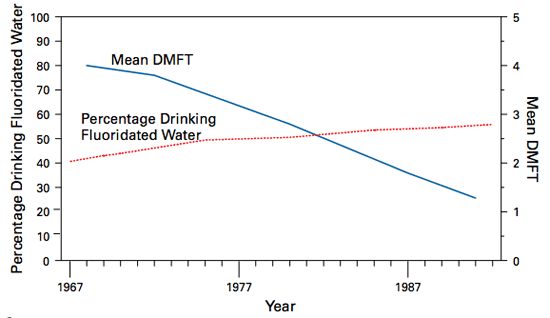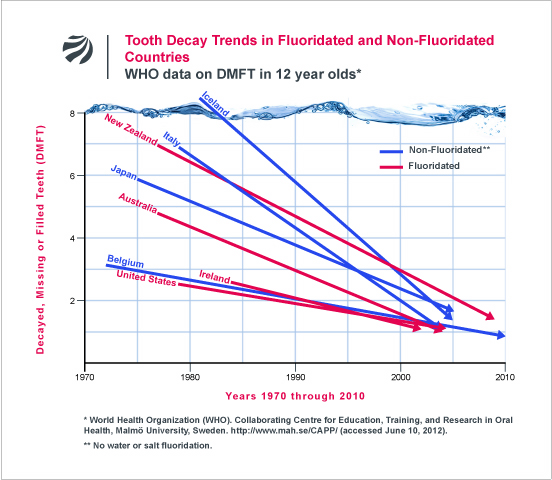Tooth Decay in F vs NF Countries
Fluoride advocates often claim that the reduction in tooth decay that has occurred since the 1950s is the result of the widespread introduction of fluoridated water. In 1999, for example, the Centers for Disease Control stated that “as a result [of water fluoridation], dental caries declined precipitously during the second half of the 20th century.” As support for this assertion, the CDC published the following figure:

SOURCE: Centers for Disease Control (1999). Achievements in Public Health, 1900-1999: Fluoridation of Drinking Water to Prevent Dental Caries. MMWR 48:933-40.
What the CDC failed to mention is that tooth decay rates have “precipitously declined” in all western countries, irrespective of whether the country ever fluoridated its water. Indeed, most western countries do not fluoridate their water and yet their tooth decay rates have declined at the same rate as the U.S. and other fluoridated countries. This fact, which is widely acknowledged in the dental literature, can be quickly demonstrated by examining the World Health Organization’s (WHO) data on tooth decay trends in each country. The following two figures and table, for example, compare the tooth decay trends in western countries with, and without, water (or salt) fluoridation.
| DMFT (Decayed, Missing & Filled teeth) Status for 12 year olds by Country – World Health Organization Data (2012) – |
|||
| Country | DMFTs | Year | Status* |
| Denmark | 0.7 | 2008 | No water fluoridation. No salt fluoridation. |
| Germany | 0.7 | 2005 | No water fluoridation. 67% salt fluoridation. |
| England | 0.7 | 2009 | 11% water fluoridation. No salt fluoridation. |
| Netherlands* | 0.8 | 2002 | No water fluoridation. No salt fluoridation. |
| Switzerland** | 0.82 | 2009 | No water fluoridation. 88% salt fluoridation. |
| Belgium | 0.9 | 2009-10 | No water fluoridation. No salt fluoridation. |
| Sweden | 0.9 | 2008 | No water fluoridation. No salt fluoridation. |
| Australia | 1.0 | 2003-2004 | 80% water fluoridation. No salt fluoridation. |
| Austria | 1.0 | 2002 |
No water fluoridation.
6% salt fluoridation.
|
| Ireland | 1.1 | 2002 | 100% water fluoridation in study. No salt fluoridation. |
| Italy | 1.1 | 2004 | No water fluoridation. No salt fluoridation. |
| United States | 1.19 | 1999-2004 | 64% water fluoridation. No salt fluoridation. |
| Finland | 1.2 | 2006 | No water fluoridation. No salt fluoridation. |
| France | 1.2 | 2006 | No water fluoridation. 65% salt fluoridation. |
| Spain | 1.3 | 2004 | 11% water fluoridation. 10% salt fluoridation. |
| Greece | 1.35 | 2005-06 | No water fluoridation. No salt fluoridation. |
| Iceland | 1.4 | 2005 | No water fluoridation. No salt fluoridation. |
| New Zealand | 1.4 | 2009 | 61% water fluoridation. No salt fluoridation. |
| Japan | 1.7 | 2005 | No water fluoridation. No salt fluoridation. |
| Norway | 1.7 | 2004 | No water fluoridation. No salt fluoridation. |
| * The Hague | ** Zurich | |||
Tooth Decay data from:
Water fluoridation data from:
Salt fluoridation data from:
|
|||
To see published research on the decline of tooth decay in the western world and specific non-fluoridated countries, click here.
-
-
Why I Changed My Mind About Water Fluoridation
To explain how I came to change my opinion about water fluoridation, I must go back to when I was an ardent advocate of the procedure. I now realize that I had learned, in my training in dentistry, only one side of the scientific controversy over fluoridation. I had been taught,
-
Water Fluoridation Challenged: Researcher Cites Decline in Tooth Decay Before Programs Began
Fluoridation of water, long credited with the large decline in tooth decay in much of the world during recent decades, might actually have played only a minor role, an Australian public health researcher has concluded after reviewing many previous studies. However, an official of the American Dental Association challenged the interpretation,
-
Fluoride & Tooth Decay: The Facts
Fact 1: Fluoride's Primary Effect is Topical, Not Systemic Water fluoridation began in the 1940s under the premise that swallowing fluoride is the most effective way to strengthen teeth. It is now known, however, that fluoride’s main benefit comes from topical contact with teeth, not from ingestion. Even if fluoridated water has a
Related Articles:
-
-
-
Tooth Decay Trends in Fluoridated vs. Unfluoridated Countries
Most western countries do not fluoridate their water and yet their tooth decay rates have declined at the same rate as the U.S. and other fluoridated countries.
-
Studies on Tooth Decay Rates After Water Fluoridation Is Stopped
For decades, the American Dental Association (ADA) has long warned that if communities end their water fluoridation programs, the rate of tooth decay will increase. In it's "Fluoridation Facts" brochure, the ADA states: "Dental decay can be expected to increase if water fluoridation in a community is discontinued for one year
-
The Mystery of Declining Tooth Decay
Large temporal reductions in tooth decay, which cannot be attributed to fluoridation, have been observed in both unfluoridated and fluoridated areas of at least eight developed countries over the past thirty years. It is now time for a scientific re-examination of the alleged enormous benefits of fluoridation.
Related Studies:
-
-
-
Countries that Fluoridate Their Water
Quick Facts: Most developed nations do not fluoridate their water. In western Europe, for example, only 3% of the population consumes fluoridated water. While 25 countries have water fluoridation programs, 11 of these countries have less than 20% of their population consuming fluoridated water: Argentina (19%), Guatemala (13%), Panama (15%), Papa
-
Water Fluoridation Status in OECD Nations
Quick Facts: Most developed nations, including 97% of western Europe, do not fluoridate their drinking water. Of the 34 countries in the Organization for Economic Cooperation and Development (OECD), only 10 have water fluoridation programs. Four of the 10 OECD countries with water fluoridation programs have less than 15% of
-
Water Fluoridation Status in Western Europe
As the following table shows, only 3% of the population in western Europe is currently consuming fluoridated water. Europe's reasons for not fluoridating its water are explained here. Despite not fluoridating its water, tooth decay rates in these western European countries are no higher than in the few western countries (e.g.,
Related Miscellaneous Content:
-




